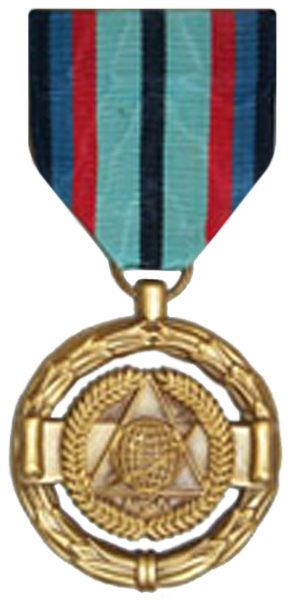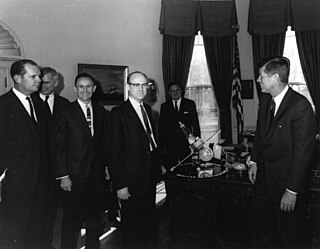Related Research Articles

Jet Propulsion Laboratory (JPL) is a federally funded research and development center in Pasadena, California, United States. Founded in 1936 by Caltech researchers, the laboratory is now owned and sponsored by the National Aeronautics and Space Administration (NASA) and administered and managed by the California Institute of Technology.

Peter C. Theisinger is the director of the Engineering and Science Directorate at the Jet Propulsion Laboratory in Pasadena, California and was the project manager of NASA's Mars Exploration Rover Mission and later project manager for the 2011 Mars Science Laboratory mission.

The USC Viterbi School of Engineering is the engineering school of the University of Southern California. It was renamed following a $52 million donation by Andrew J. Viterbi, co-founder of Qualcomm.

George David Low was an American aerospace executive and a NASA astronaut. With undergraduate degrees in physics and mechanical engineering and a master's degree in aeronautics and astronautics, he worked in the Jet Propulsion Laboratory (JPL) at the California Institute of Technology in the early 80's, before being picked as an astronaut candidate by NASA in 1984. In addition to holding some technical assignments, he logged more than 700 hours in space, before he left NASA in 1996 to pursue a career in the private sector. He was the son of George M. Low, the manager of the Apollo Spacecraft Program Office, and later, the 14th president of Rensselaer Polytechnic Institute.

Eugene Huu-Chau "Gene" Trinh is a Vietnamese American biochemist who flew aboard NASA Space Shuttle mission STS-50 as a Payload Specialist, becoming the first Vietnamese American astronaut in space and the second Vietnamese in space.

The NASA Exceptional Achievement Medal is an award of the National Aeronautics and Space Administration established in 1991. The medal is awarded to both civilian members of NASA and military astronauts.

Garrett Erin Reisman is an American engineer and former NASA astronaut. He was a backup crew member for Expedition 15 and joined Expedition 16 aboard the International Space Station for a short time before becoming a member of Expedition 17. He returned to Earth on June 14, 2008 on board STS-124 on Space Shuttle Discovery. He was a member of the STS-132 mission that traveled to the International Space Station aboard Space Shuttle Atlantis from May 14 to 26, 2010. He is a consultant at SpaceX and a Professor of Astronautics Practice at the University of Southern California's Viterbi School of Engineering.

Donna Lee Shirley is a former manager of Mars Exploration at the NASA Jet Propulsion Laboratory. She is the author of the book Managing Martians: The Extraordinary Story of a Woman's Lifelong Quest to Get to Mars—and of the Team Behind the Space Robot That Has Captured the Imagination of the World.
Ewald Heer is an aerospace engineer, author and professor who has worked on robotics, artificial intelligence (AI), and large space structures. He is primarily known for his work and advocacy for the development of intelligent robotic systems used to explorate and operate in space.

Adam Diedrich Steltzner is an American NASA engineer who works for the Jet Propulsion Laboratory (JPL). He worked on several flight projects including Galileo, Cassini, Mars Pathfinder, Mars Exploration Rovers (MER). He was the lead engineer of the Mars Science Laboratory's EDL phase, and helped design, build and test the sky crane landing system.

Bobak Ferdowsi is a flight engineer at NASA's Jet Propulsion Laboratory. He served on the Cassini–Huygens and Mars Science Laboratory Curiosity missions.

Robert J. "Bob" Parks was an American aerospace engineer and pioneer in the space program where he was intricately involved and/or directed for some of the most historic and important U.S. unmanned space missions. Over a 40-year tenure at the Jet Propulsion Laboratory (JPL/NASA), located in Pasadena, California, Parks’ impact was essential to helping the United States lead the world in space exploration. He served as Guidance Engineer for Explorer 1, the first successfully launched satellite by the United States. He directed the initial flyby missions to the Moon, the first soft landing on the Moon, Earth's first successful mission to another planet and initial missions to Mars, Saturn, Jupiter and Uranus.

The Cold Atom Laboratory (CAL) is an experimental instrument on board the ISS, which launched in 2018. It creates an extremely cold environment in microgravity in order to study behaviour of atoms in these conditions.

Michael M. Watkins is an American engineer, scientist, and a Professor of Aerospace and Geophysics at the California Institute of Technology (Caltech). He previously served as the 9th director of NASA's Jet Propulsion Laboratory in Pasadena, California, and as a vice president of Caltech, which staffs and manages JPL for NASA. His directorial position was effective from July 1, 2016 to August 20, 2021.
John R. Tucker was an American physicist who made several contributions to the fields of electronics, physics and microwave theory, known for generalizing the microwave mixer theory and presenting the body of work, known as the "Tucker theory", and for his fundamental theoretical contributions which resulted into various advancements in experimental Submillimeter astronomy. He is also credited with laying down some of the technological foundations for making practical Quantum computing possible.

Vandana "Vandi" Verma is a space roboticist and chief engineer at NASA's Jet Propulsion Laboratory, known for driving the Mars rovers, notably Curiosity and Perseverance, using software including PLEXIL programming technology that she co-wrote and developed.
The Ann and H.J. Smead Department of Aerospace Engineering Sciences is a department within the College of Engineering & Applied Science at the University of Colorado Boulder, providing aerospace education and research. Housed primarily in the Aerospace Engineering Sciences building on the university's East Campus in Boulder, it awards baccalaureate, masters, and PhD degrees, as well as certificates, graduating approximately 225 students annually. The Ann and H.J. Smead Department of Aerospace Engineering Sciences is ranked 10th in the nation in both undergraduate and graduate aerospace engineering education among public universities by US News & World Report.
Josette Bellan is a Romanian-French-American aerospace engineer and fluid dynamicist known for her research on turbulence in high-pressure reactions, and on the interactions between fluid dynamics and thermodynamics in these reactions. She is a senior research scientist at the Jet Propulsion Laboratory (JPL) and visiting associate in the Department of Mechanical and Civil Engineering of the California Institute of Technology (Caltech).
Andrea P. Belz is an American innovation engineer, academic and author. She is a Professor of Practice in Industrial and Systems Engineering and the Vice Dean of Transformative Initiatives in the Viterbi School of Engineering at the University of Southern California (USC).
Christina Hernández is a Mexican-American systems engineer at NASA. She was involved in STEM programs, which led her to a career in NASA where she has worked on the Mars Perseverance Rover, along with being a micrometeoroid and orbital debris specialist at the Jet Propulsion Laboratory. Her contribution to aerospace involved adding safety within spacecraft. Also as an advocate for Latinas in STEM, Hernandez was a recipient of the Hispanic Heritage Foundation awards in 2021.
References
- 1 2 3 "Cold Atom Laboratory:People". Jet Propulsion Laboratory. Caltech. Archived from the original on 29 March 2013. Retrieved 12 December 2014.
- ↑ "Curiosity's Seven Minutes of Terror". NASA.gov. June 22, 2012. Retrieved August 6, 2012.
- ↑ "Deep Space 1". NASA.gov. June 22, 2012. Retrieved August 6, 2012.
- ↑ "Ion Propulsion". jpl.nasa.gov. September 3, 2002. Retrieved August 6, 2012.
- ↑ "AIAA award". Jet Propulsion Laboratory. USC. Retrieved 10 June 2005.
- ↑ WYSK (August 27, 2012). "Women Talk: 10+ Questions With Rocket Scientist, Dr. Anita Sengupta". Women You Should Know. Retrieved April 3, 2015.
- ↑ "Landing a rover was career highlight, says Anita Sengupta". The Hindu. August 21, 2013. Retrieved April 3, 2015.
- ↑ Andy Meek. "What It's Like To Be One Of The Few Female Aerospace Engineers". Fast Company. Retrieved April 3, 2015.
- ↑ "NASA-JPL Systems Engineer and Viterbi School Alumna on Early Influences and Designing Curiosity's Parachute". USC - Viterbi School of Engineering. Retrieved 12 December 2014.
- ↑ "Team | Hyperloop One". 2018-10-20. Archived from the original on 2018-10-20. Retrieved 2019-03-07.
- ↑ "ASX team". Archived from the original on 2019-03-07. Retrieved 2019-03-07.
- ↑ "Soft Mars landing thanks to engineer from Bishopbriggs". HeraldScotland. 3 September 2012. Retrieved 2019-02-26.
- ↑ "At home in space - Scientist hooked on Spock as 6-year-old". www.telegraphindia.com. Retrieved 2019-02-26.